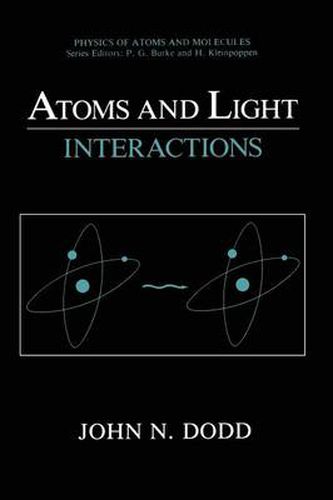Readings Newsletter
Become a Readings Member to make your shopping experience even easier.
Sign in or sign up for free!
You’re not far away from qualifying for FREE standard shipping within Australia
You’ve qualified for FREE standard shipping within Australia
The cart is loading…






This title is printed to order. This book may have been self-published. If so, we cannot guarantee the quality of the content. In the main most books will have gone through the editing process however some may not. We therefore suggest that you be aware of this before ordering this book. If in doubt check either the author or publisher’s details as we are unable to accept any returns unless they are faulty. Please contact us if you have any questions.
This book discusses the interaction of light with atoms, concentrating on the semiclassical descriptions of the processes. It begins by discussing the classical theory of electromagnetic radiation and its interaction with a classical charged dipole oscillator. Then, in a pivotal chapter, the interaction with a free charge is described (the Compton effect); it is shown that, in order to give agreement with observation, certain quantum rules must be introduced. The book then proceeds to discuss the interaction from this point of view-light always being described classically, atoms described quantum-mechanically, with quantum rules for the interaction. Subsequent chapters deal with stimulated emission and absorption, spontaneous emission and decay, the general problem of light stimulating and being scattered from the two-state atom, the photoelectric effect, and photoelectric counting statistics. Finally the author gives a personal view on the nature of light and his own way of looking at certain paradoxes. The writing of this book was originally conceived as a collaboration between the present author and a colleague of former years, Alan V. Durrant. Indeed, some preliminary exchange of ideas took place in the mid-1970s. But the problems of joint-authorship from antipodean positions proved too difficult and the project was abandoned. I would like to record my indebted ness to him for the stimulation of this early association. I also acknowledge the encouragement of my colleagues at the Univer sity of Otago. Special reference must be made to D. M.
$9.00 standard shipping within Australia
FREE standard shipping within Australia for orders over $100.00
Express & International shipping calculated at checkout
This title is printed to order. This book may have been self-published. If so, we cannot guarantee the quality of the content. In the main most books will have gone through the editing process however some may not. We therefore suggest that you be aware of this before ordering this book. If in doubt check either the author or publisher’s details as we are unable to accept any returns unless they are faulty. Please contact us if you have any questions.
This book discusses the interaction of light with atoms, concentrating on the semiclassical descriptions of the processes. It begins by discussing the classical theory of electromagnetic radiation and its interaction with a classical charged dipole oscillator. Then, in a pivotal chapter, the interaction with a free charge is described (the Compton effect); it is shown that, in order to give agreement with observation, certain quantum rules must be introduced. The book then proceeds to discuss the interaction from this point of view-light always being described classically, atoms described quantum-mechanically, with quantum rules for the interaction. Subsequent chapters deal with stimulated emission and absorption, spontaneous emission and decay, the general problem of light stimulating and being scattered from the two-state atom, the photoelectric effect, and photoelectric counting statistics. Finally the author gives a personal view on the nature of light and his own way of looking at certain paradoxes. The writing of this book was originally conceived as a collaboration between the present author and a colleague of former years, Alan V. Durrant. Indeed, some preliminary exchange of ideas took place in the mid-1970s. But the problems of joint-authorship from antipodean positions proved too difficult and the project was abandoned. I would like to record my indebted ness to him for the stimulation of this early association. I also acknowledge the encouragement of my colleagues at the Univer sity of Otago. Special reference must be made to D. M.